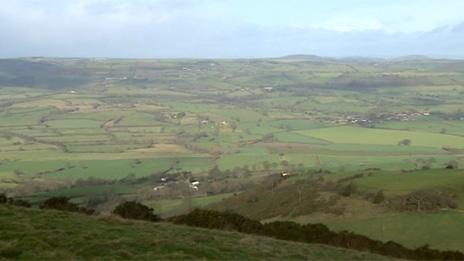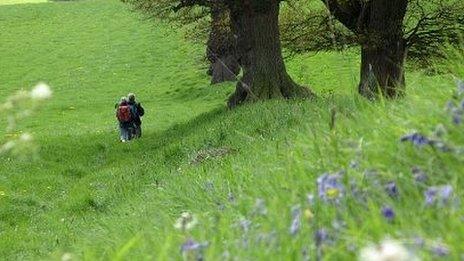Offa's Dyke evidence at Chirk suggests earlier build
- Published

The site was damaged in August 2013
Archaeologists have uncovered evidence which suggests that Offa's Dyke may have been built up to 200 years earlier than thought.
Samples from Clwyd-Powys Archaeological Trust excavations on a stretch of the dyke have been radiocarbon dated to the second half of the 6th Century.
Historians have always associated the dyke with King Offa who ruled the kingdom of Mercia in the 8th Century.
But now archaeologists believe it might have been in use before he ruled.
The trust said it was a "tremendously exciting discovery".
The excavations were taken from a section of the protected ancient monument at Chirk near the Shropshire border.
'Assumptions'
It had been believed that the linear earthwork stretching 177 miles (285km) was built by King Offa of Mercia during his reign between 757 and 796.
However there has been no firm archaeological evidence to support this.
But now the trust claim accurate scientific dates have been obtained from Offa's Dyke for the first time.
The trust said the dated material came from an ancient layer of re-deposited turf underneath the bank suggesting that this material was laid down as part of the construction process.
"This is a tremendously exciting discovery which means we must re-think some of our assumptions about this important monument", said Paul Belford, the trust's director.
"Certainly the dyke was built to make a statement about the power of the kingdom of Mercia."
'Further work'
Carbon dating tests revealed a 95% probability that the Chirk section of the dyke had been built between 430 and 652.
"It is now likely that parts of the dyke system was in place before Offa's time but it is also likely that he would have consolidated the existing network into what we now call Offa's Dyke," said Mr Belford.
"It is now clear that it was not the work of a single ruler but a longer-term project that began at an earlier stage in the development of the kingdom."
Offa's Dyke is the longest linear earthwork in the UK, and one of the longest in Europe.
The modern border between England and Wales closely follows much of the route of the dyke.
"Of course these samples are from only one section of the Dyke," said Mr Belford.
"Further work is needed on other parts of this enigmatic monument before we can really say who built it and why."
- Published4 February 2014

- Published19 August 2013

- Published16 August 2013

- Published1 February 2012

- Published11 October 2011

- Published10 July 2011
